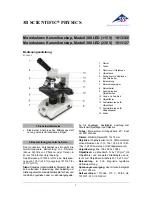
▪
While looking through the eyepiece and using the course-focus
adjustment, slowly move the stage/specimen AWAY from the
objective until the image is clear.
▪
Rotate the 10X objective into place. While looking through the
eyepiece and using the fine-focus adjustment, clearly focus the
image, that now appears enlarged compared to that observed
through the 4X scanning objective. You will notice, increasing
magnification decreases the field-of-view or relative observable
area of the specimen.
▪
At this point, it may be beneficial to diminish the amount of light
entering the specimen. Decreasing the aperture of the iris
diaphragm will reduce glare and increase contrast in the image.
Use of the iris diaphragm will require experience. It is important to
select both the magnification and the degree of contrast that
renders the optimum detail in the observed specimen. You may
also need to regulate the amount of light with the Dimmer Dial.
▪
Rotate the 40X objective into place and repeat the steps taken for
the initial magnification increase. The objectives of the microscope
are parfocal, meaning that the gross image will remain in focus
when changing through the objectives. It should only be necessary
to use the fine-focus adjustment once the initial image is clearly
viewed at low magnification. With the 40X it is necessary to be
careful not to touch the slide or any liquid specimen. The 40X is
not sealed against liquid and could be damaged. If the specimen
will not focus, make sure that you are using the correct thickness
of slides.
▪
In order to obtain maximum resolution of the 100x oil immersion
lens, it is necessary to apply immersion oil to the top of the cover
glass on the slide. Use the smallest amount possible. A tiny drop
goes a long way in use. It is extremely important that the oil from
the 100x is not transferred to the other objectives. The oil will
damage the non-oil immersion lens.
1.
Use a very small amount of Immersion oil. Immersion Oil can
be purchased from Carolina. # 853311 15ml bottle.
2.
After viewing with the 100 x lens, clean the oil from the glass
surface and anywhere the oil has come in contact with the
objective. It is important to clean all the oil from the slide as
well so that the oil does not damage the other objectives.
▪
It will be useful to repeat these procedures until they become
second nature. Your familiarity with them will add to the
usefulness of the microscope and to the ease in interpreting the
information it provides.


























